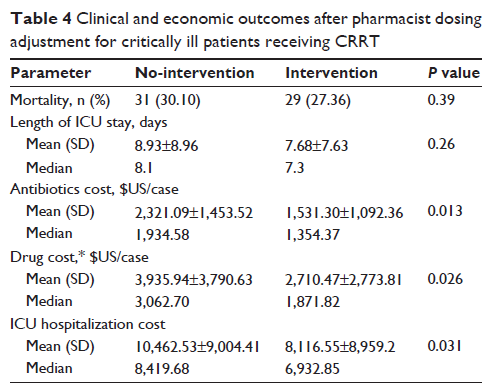9 1 2 3 6
论文已发表
注册即可获取德孚的最新动态
IF 收录期刊
- 2.6 Breast Cancer (Dove Med Press)
- 3.9 Clin Epidemiol
- 3.3 Cancer Manag Res
- 3.9 Infect Drug Resist
- 3.6 Clin Interv Aging
- 4.8 Drug Des Dev Ther
- 2.8 Int J Chronic Obstr
- 8.0 Int J Nanomed
- 2.3 Int J Women's Health
- 3.2 Neuropsych Dis Treat
- 4.0 OncoTargets Ther
- 2.2 Patient Prefer Adher
- 2.8 Ther Clin Risk Manag
- 2.7 J Pain Res
- 3.3 Diabet Metab Synd Ob
- 4.3 Psychol Res Behav Ma
- 3.4 Nat Sci Sleep
- 1.9 Pharmgenomics Pers Med
- 3.5 Risk Manag Healthc Policy
- 4.5 J Inflamm Res
- 2.3 Int J Gen Med
- 4.1 J Hepatocell Carcinoma
- 3.2 J Asthma Allergy
- 2.3 Clin Cosmet Investig Dermatol
- 3.3 J Multidiscip Healthc

已发表论文
对持续接受肾脏移植治疗的危重病人进行药师用药量调整的有效性:一项比较研究
Authors Jiang SP, Zhu ZY, Wu XL, Lu XY, Zhang XG, Wu BH
Published Date June 2014 Volume 2014:10 Pages 405—412
DOI http://dx.doi.org/10.2147/TCRM.S59187
Received 14 December 2013, Accepted 1 February 2014, Published 3 June 2014
Background: The impact of continuous renal replacement therapy (CRRT) on drug removal is complicated; pharmacist dosing adjustment for these patients may be advantageous. This study aims to describe the development and implementation of pharmacist dosing adjustment for critically ill patients receiving CRRT and to examine the effectiveness of pharmacist interventions.
Methods: A comparative study was conducted in an intensive care unit (ICU) of a university-affiliated hospital. Patients receiving CRRT in the intervention group received specialized pharmacy dosing service from pharmacists, whereas patients in the no-intervention group received routine medical care without pharmacist involvement. The two phases were compared to evaluate the outcome of pharmacist dosing adjustment.
Results: The pharmacist carried out 233 dosing adjustment recommendations for patients receiving CRRT, and 212 (90.98%) of the recommendations were well accepted by the physicians. Changes in CRRT-related variables (n=144, 61.81%) were the most common risk factors for dosing errors, whereas antibiotics (n=168, 72.10%) were the medications most commonly associated with dosing errors. Pharmacist dosing adjustment resulted in a US$2,345.98 ICU cost savings per critically ill patient receiving CRRT. Suspected adverse drug events in the intervention group were significantly lower than those in the preintervention group (35 in 27 patients versus [vs] 18 in eleven patients, P <0.001). However, there was no significant difference between length of ICU stay and mortality after pharmacist dosing adjustment, which was 8.93 days vs 7.68 days (P =0.26) and 30.10% vs 27.36% (P =0.39), respectively.
Conclusion: Pharmacist dosing adjustment for patients receiving CRRT was well accepted by physicians, and was related with lower adverse drug event rates and ICU cost savings. These results may support the development of strategies to include a pharmacist in the multidisciplinary ICU team.
Keywords: pharmacist interventions, drug dosing adjustment, adverse drug event, cost saving, CRRT
Methods: A comparative study was conducted in an intensive care unit (ICU) of a university-affiliated hospital. Patients receiving CRRT in the intervention group received specialized pharmacy dosing service from pharmacists, whereas patients in the no-intervention group received routine medical care without pharmacist involvement. The two phases were compared to evaluate the outcome of pharmacist dosing adjustment.
Results: The pharmacist carried out 233 dosing adjustment recommendations for patients receiving CRRT, and 212 (90.98%) of the recommendations were well accepted by the physicians. Changes in CRRT-related variables (n=144, 61.81%) were the most common risk factors for dosing errors, whereas antibiotics (n=168, 72.10%) were the medications most commonly associated with dosing errors. Pharmacist dosing adjustment resulted in a US$2,345.98 ICU cost savings per critically ill patient receiving CRRT. Suspected adverse drug events in the intervention group were significantly lower than those in the preintervention group (35 in 27 patients versus [vs] 18 in eleven patients, P <0.001). However, there was no significant difference between length of ICU stay and mortality after pharmacist dosing adjustment, which was 8.93 days vs 7.68 days (P =0.26) and 30.10% vs 27.36% (P =0.39), respectively.
Conclusion: Pharmacist dosing adjustment for patients receiving CRRT was well accepted by physicians, and was related with lower adverse drug event rates and ICU cost savings. These results may support the development of strategies to include a pharmacist in the multidisciplinary ICU team.
Keywords: pharmacist interventions, drug dosing adjustment, adverse drug event, cost saving, CRRT
